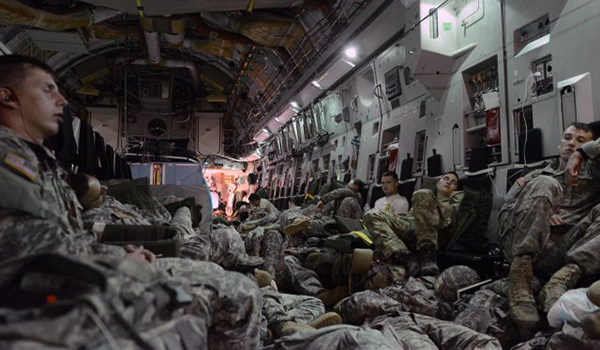
Ask the Flight Surgeon / By CPT Albert J. Lee, MD: Q: I have sleep apnea. I use a breathing machine while sleeping. Why is it a disqualifying condition? What other treatments can pilots use? What medical documentation do I need for this physical and future physicals?

Soldiers, who are deployed, average just three hours of sleep a night. / DAVID VERGUN, ARMY.MIL
FS: Obstructive sleep apnea (OSA) is a condition where a person stops breathing or has difficulty breathing due to an obstruction of the airway during sleep. When breathing becomes inefficient or stops, the brain will send a signal to wake the person up. These events can occur several to many times each night resulting in fragmented and poor quality sleep. Unrestful nights can lead to daytime drowsiness which is particularly dangerous for driving and flying. Studies have shown motor vehicle accidents are two to three times more common among people with OSA compared to people without OSA. Also, people with mild to moderate OSA could have degradation in their performance equivalent to a 0.06-0.08% blood alcohol level, which would be illegal in most states if caused by alcohol consumption. The National Transportation Safety Board (NTSB) reported that pilots with OSA have a six-fold increase in the risk of having an aviation mishap and designated OSA as the “Most Wanted” medical risk factor to be mitigated in 2015.
Symptoms that are concerning for OSA include daytime drowsiness, fatigue, nonrestorative sleep, insomnia, or frequent awaking at night with breath holding, gasping or choking. Spouses or bed partners may also observe loud snoring or breathing interruptions during sleep. Certain medical conditions have also been associated with OSA including blood pressure, mood disorders, cognitive dysfunction, heart disease, stroke, congestive heart failure, atrial fibrillation and type 2 diabetes. If a patient reports these symptoms and/or has a history of these medical conditions, a diagnostic sleep study is usually indicated. An overnight polysomnogram, also known as a sleep study, is the most common and reliable method for diagnosing OSA. During the evaluation, the patient is observed sleeping in a specialized laboratory to monitor vital signs and other common indicators of sleep disorders. Home testing kits are also available for diagnosing OSA, however, they are not currently accepted for meeting waiver requirements. The report from the study will provide an important statistic called the apnea-hypopnea index or AHI. The AHI is the number of very shallow or absent breathing events per hour. This number is used to determine the severity of OSA. An AHI of 0-4 events per hour is considered normal. An AHI of 5-14 is considered mild, 15-29 moderate and 30 or greater severe.
About 20-30% of males and 10-15% of females in North America have OSA. Several risk factors have been identified for OSA including age, gender, body habitus, anatomical abnormalities of the upper airway and smoking. The single most significant risk factor is obesity. A study of 1000 adult patients showed that 63% of obese males (Body Mass Index >30 kg/m2) and 22% of obese females had OSA.
What treatment options are available?
The cornerstone of OSA treatment is the combination of weight loss and nightly use of a continuous positive airway pressure (CPAP) machine. Weight loss can reduce airway obstruction and in many cases, resolve OSA alone. The CPAP machine uses continuous air pressure to prevent airway collapse during sleep and requires proper and consistent use each night to be effective in managing OSA. Other treatment options include surgery, an oral appliance, and hypoglossal nerve stimulation.
What do I need to do to continue flying?
OSA is a disqualifying medical condition that requires a waiver to continue flying. To be considered for a waiver, a crewmember must be successfully treated with any of the above methods and have a repeat sleep study showing an AHI of 5 or less. If the crewmember uses a CPAP machine, a compliance report is required to show more than 4 hours of nightly use on at least 80% of nights to qualify. The crewmember must also see a sleep medicine, pulmonary or ear, nose and throat (ENT) specialist every year to confirm that treatment is adequate. If an oral appliance is used, a repeat sleep study should be done every 4-5 years with the oral appliance to ensure continued adequate treatment.
OSA is a very manageable condition, and when treated adequately, most patients report a significant improvement in the quality of life due to more restful sleep. If you suspect that you might have sleep apnea, please see your local flight surgeon. Doc Lee
Questions?
If you have a question you would like addressed, email it to This email address is being protected from spambots. You need JavaScript enabled to view it.; we’ll try to address it in the future. See your unit flight surgeon for your personal health issues. The views and opinions offered are those of the author and researchers and should not be construed as an official Department of the Army position unless otherwise stated
CPT (Dr.) Albert Lee is a flight surgeon at the U.S. Army School of Aviation Medicine, Fort Rucker, AL.










